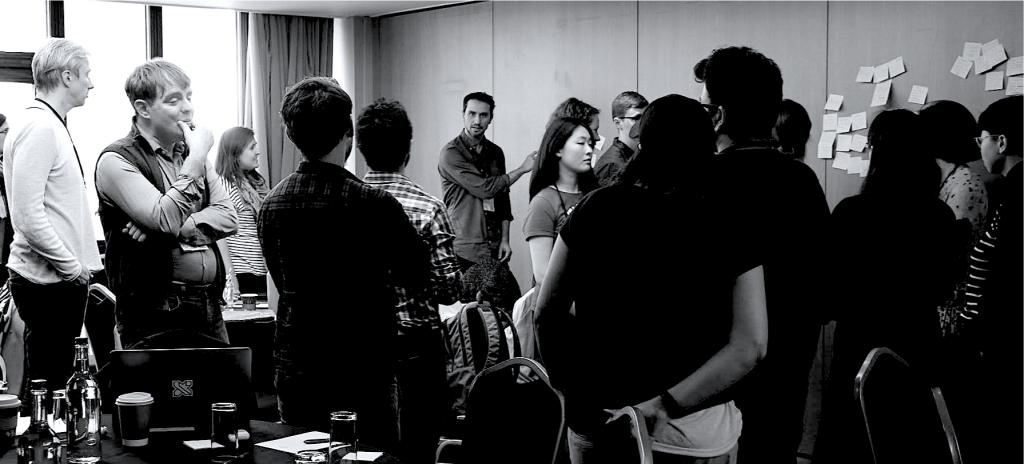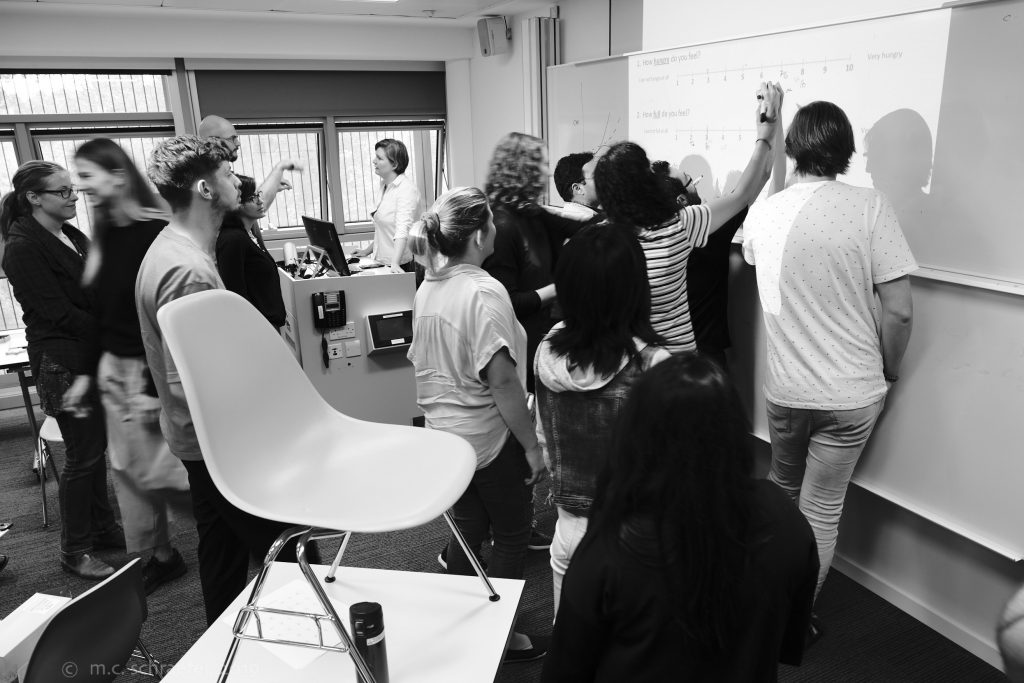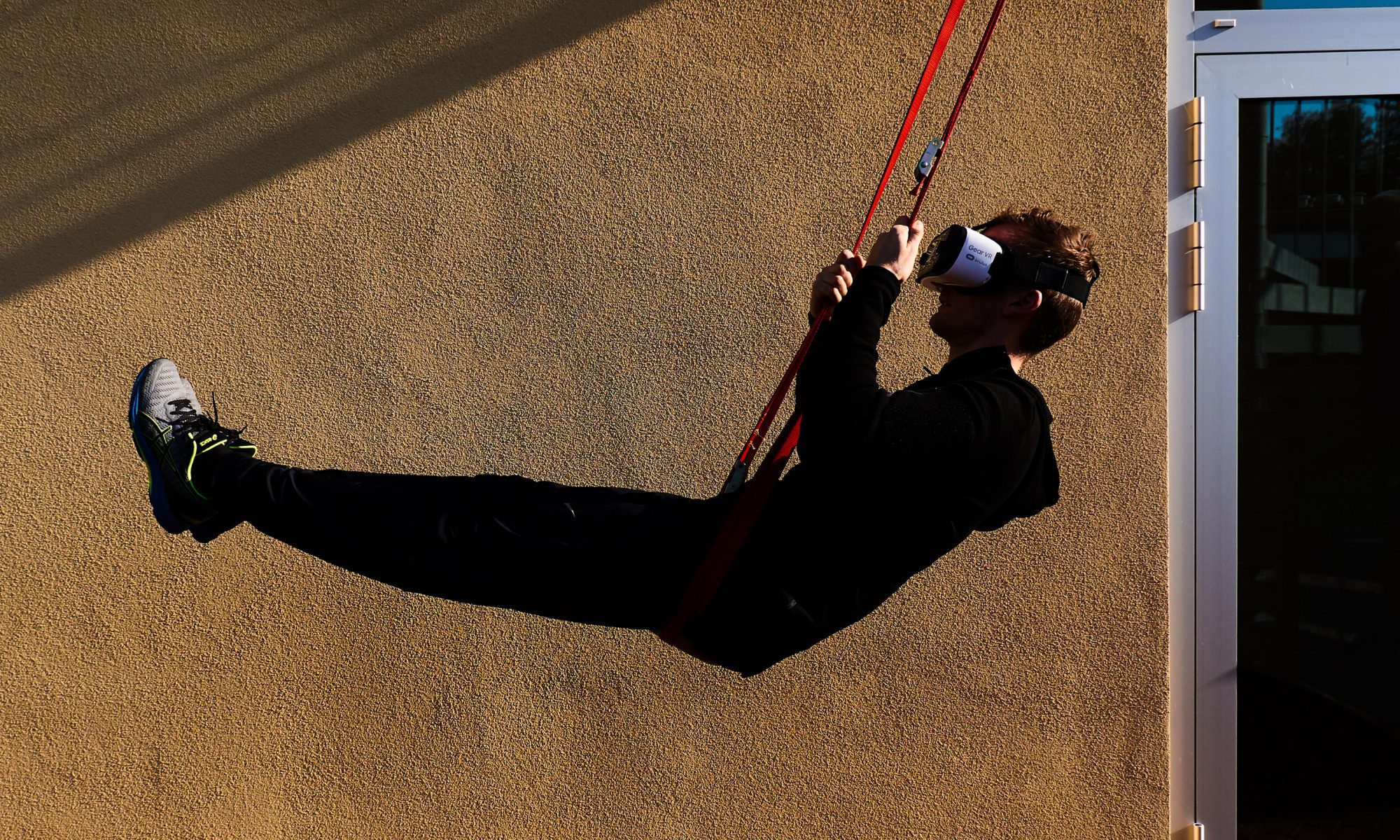Welcome to The Inbodied Interaction Design Cheat Sheet – Beta 0.1 – SIDE B or
HOW to Use INBODIED INTERACTION (II) tools and techniques to Design Computational Interactive Tecnologies to support human performance, ranging from Resilience to Brilliance
Reminder from the Primer, Side A: Inbodied Intearction is about how to align our designs of computational, interactive systems with how we work, as complex physical, electrical, chemical, neurological (ie – inbodied) systems. The driving idea is that by aligning ALL our designs for individual, group and infrastructure support with our inbodied-ness, we will, develop designs that help #make normal better, for all, at scale. This sheet is a fast overview of how to apply the II approach so you can start testing, using and applying the approach.
This Sheet has two sides :
you are on SIDE B – that guides you through key questions on How To Create your Design Space with II concepts.
If you’d like a refresher of those II concepts, that’s on SIDE A, an inbodied interaction concept Primer.
This SIDE of the sheet includes
Your comments/questions to help TUNE this guide are much much appreciated
OUR INBODIED STATE = the FOUNDATIONS FOR ALL OUR EXPERIENCES. The in5/c4 are the paths to TUNE these foundations for in context resilience
From the Primer, we see that the states of the in5/c4 are the foundations for everything we experience. By tuning the in5/c4 we affect how we are able to engage any environment and how we adapt in/to/with that environment.
Developing an II Design Space: Using the Inbodied Interaction continua and materials, we can create a design space to establish
- what adaptation is sought (kinder nicer smarter faster??),
- what are the core values/motivations underpinning this adaptation?
- how will participants assess success(es)? ie how do success measures align with and reflect desired adaptation?
- how we as designers will assess our success?
From here, our core questions fundamentally include:
- how and which of the in5/c4 will be explicitly or implicitly incorporated to underpin in the intervention?.
- where on each of the II continua will the intervention sit?
- What is the cycle of engagement across these continua (what is the cycle? what are its macro, messo, micro components?)
- where is discomfort anticipated and embraced in the design?
These questions let us probe why we are making the choices we are about the intervention. Eg why is this X only an outsourcing or insourcing intervention? Does it need one or several messo cycles? how are these decisions aligned with theories or models of practice that suggest success?
The result of this process is an articulated design space from which clearer specs can be developed. This space is also a map of our design territory. As such, we can also use these documents to inform co-design with our stakeholders in the process. therefore, looks at how to align the in5/c4, to support the adaptations sought.
Questions to Craft an II informed Design Space

A key design opportunity we have found in Inbodied Interaction is to
(1) align aspiration with the intervention. And then,
(2) align the design with our inbodied (in5/c4).
- START WITH: ALIGN WITH ASPIRATION, not with predetermined interverntion. TO be clear, align the design means rather than suggest to someone that they need to stand more at work – which could be part of a strategy for health for sure because that aligns with our physiological need to move for various internal processes not detailed here . If that workplace is where the intervention is to take place, we would explore what are the motivating values for these folks in this context – how do they want to feel? about what around work? and then, how can we support these values within a work place context? If practicing standing is part of that support, our next question might be how make that process as safe and effortless as possible?
- ALIGN DESIGN WITH INBODIED in5/c4. A related critical question is that: given the aspirations of say this work community to be healthier, and individuals to be less tired, be stronger, be happier, for example, choosing to focus on prompting standing may be a really poor locus for best effect. A broader exploration of the in5, perhaps oriented around “MOVE” and how that affects the motivating aspiration, may create more exciting and lasting approaches and practices than “stand up at work.”
SIde Challenge: we can test if the chosen focus/intervention the best use of computational interaction – and its associated costs? When we start with the aspiration rather than the presumed intervention, and when we ask, Where are batteries required -or where is our computational interactive technology of benefit – we can also test our own assumptions about our approach against these criteria for inbodied interaction. Sometimes the computational tech may be surplus to requirements ( for example, elsewhere i have suggested if more standing is desired, Burn the Chairs no batteries require).
The Skeleton Worksheet below goes through the questions to explore towards developing an inbodied interaction design using the above align the design orientation.
The Skeleton Worksheet to prep an Inbodied Interaction Design Space
A first question is “what is the adaptation you seek”
This adaptation can be anything: to be more calm; becoming more creative; learning a new language; getting faster in a 5k run. In the example below, we focused on supporting enhancing creativity.
A related question is: what is the value around which this adaptation is aligned?
Another way of asking this is to unpack what are the attributes within the sought adaptation? eg in our creativity example below, better creativity for the folks working at an advertising agency could translate into better campaigns, promotion, opportunities, success.
A second question is – how do you evaluate success?
There may be personal markers of success like interrupting less in conversations ; running faster; meditating longer. Many -er’s.
In many cases there are established assessments that can be used over the course of an exploration.
WE CAN. also consider both qualitative and quantitative assessments as well as frequency of these assessments.
There may also be success criteria that are important for you as a designer rather than just benefit for participants. Such as: for insourcing with a time-limited intervention – are the participants still using the KSP’s from the study weeks, months, years later?
A third question: what is the imagined life cycle of this interaction?
Within this question is also the EXIT STRATEGY question (as per side A) – what is the ending of this technology? In HCI we rarely have time to ask this question. We want to know that it works now for whatever the “now” context is.
In inbodied interaction, where we are also interested in quality of life, over the lifecourse, considering the effects of interactions both now, and ten years from now, may be novel – because we are driven by component parts. BUt – what happens to our designs when we consider interaction longevity as a design affordance/constraint. Indeed, TIME for each phase within the lifecycle – from a macro, messo and micro perspective can also be mapped out explicitly in this method. Here is also where we may consider the EXIT STRATEGY – where the off ramp is – for our design.
Where situate the design within the CONTINUA ?
Where and when in the design space are the core II continua (described in the Primer and detailed in the Experiment in a Box paper) of
insource-outsource
heuristic-habit
raw-cyborg
feature as deliberate attributes of the design space you’re building for your intervention?
How support both sides of TUNING?
As noted on Side A – tuning considers three components: (1) an experience (2) how that experience is mediated by Knowledge Skills and Practice (KSP) and (3) how it comes to be felt internally (consciously perceived and interpreted). Tuning is about exploring how to dial in each of these components, across contexts, to support optimal adaptation via connecting KSP and perception, towards enabling performance.
Thus questions to be explored, on the FELT side of the Tuning experience: what are the signals and perceptions around which we want to develop awareness? What are the physiological processes we can draw on to support this?
Questions to be explored, on the ADAPTATION side of the Tuning experience
What are the Knowledge Skills and Practice (KSP) parts to help support, dial in, refine that awareness? and improve the experience? in other words how is KSP connected to inbodied awareness of the experience the KSP is helping to create?
HOW do we design interventions to build these connections?
Where are the in5 and c4 in your design?
As per the Primer (side A of this sheet) each of the inbodied 5 (in5) and circumbodied 4 (c4) are interconnected. As all experiences are filtered via the current state of the inbodied – of our homeostatic state – then the in5 become the foundation of any other adaptation or practice. THey also complement adaptations and processes. We may in a design focus on one particular attribute, but where the larger design map may consider at first where eac of the in5/c4 have a role in whatever the adaptation may be.
We can walk through EACH of the in5, c4, to consider the two sides of the TUNING experience – awareness of the internal felt experience of these parameters and also how improving ksp of these parameters may better support the adaptation desired. By doing such a walk-through, we can explore which attributes are of particular relevance for our intervention.
What are the Discomfortable Parts?
it’s useful to dig into what makes the particular practice – whether insourced or outsourced – difficult to the point of being unappealing, repulsive, averted?
In physical exercise, we often here well if that doesn’t appeal to you find something that does; the main thing is you stick with it.
So people just go run or just go lift weights. Great. but for overall health and longevity, likely insufficient. Escaping discomfort is not life. How sit with that?
An Inbodied Interaction Design Space Frame- checklist
In exploring the above questions, the resulting documents or design frame will include thoughts around
- What the intervention is to support,
- What the values/motivations are
- How and where the main focus of the intervention will leverage the in5/c4 for that support
- How the intervention uses each of the continua to support where the design is situated along those continua
- What cylces/phases may be included.
- The overall longevity of the intervention, including its exit strategy.
- How implicitly or explicitly TUNING is to be instantiated within WHAT experience to connect KSP to FEELING
- What are the explicit Signals/FEELINGs to be developed if any?
- What is the explicit KSP – if any – to be developed?
- How success is to be evaluated for the intervention/designers and for the participants
- If there are phases of discomfort, how and where they are anticipated, incorporated, supported

Example for these Questions in use: CREATIVITY
ADAPTATION SOUGHT: In a study we describe in the Experiment in a Box paper (details here), the advertising group we were working with was keen to improve their individual member Creativity – using a more guided insourcing, raw, heuristic continua approach.
EVALUATION OF SUCCESS: we used standard assessments in the literature of both creativity and cognitive executive functioning, as well as qualitative reflections.
We postulated with a group of professional creatives that testing out skills on the in5 would improve these measures, week on week. We also valued personal reflections of overall “feeling” that we anticipated would also improve over the course of the intervention. Another criteria of success for us as designers, but not necessarily a target for the participants was continuing to use the techniques beyond the study.
LIFECYCLE : we designed an intervention to last 6 weeks: one week preparation; 5 weeks to explore in5 approaches (we did not integrate C4 explicitly); the whole lifecycle of the approach however was to use the 6 weeks to develop KSP that would last, effectively, forever. We focused on exploring one heuristic per in5. We also connected with the participants months and now years after the study to see continued practice.
CONTINUA – this was deliberately designed to support insourcing ownership of in5 attributes, exploring heuristic instantiation, a design technology to get off technology approach, and so more towards the raw than the cyborg as design goal. A side effect of the process of insourcing, of helping participants feel safe and confident to explore and test different ways to instantiate a heuristic, they expressed greater confidence in being able to apply this approach to other parts of health explorations. In other words, they developed a more exploratory confidence, what we might call a more try it to tune it mind set. Thus, even if they choose more outsourced options for their health practices in the future – like getting prepared meal deliveries – they have the skills to evaluate the options availalbe, and more knowledge of how to evaluate their benefits..
SUPPORT FOR BOTH SIDES OF TUNING – For the feeling side of tuning with heuristic exploration to build ksp, we used explicit discussion of the ways the heuristics were operationalised, and why these particular heuristics. We connected these ksp practices with guided reflection on how people felt each week with a range of mood/wellbeing questions. Please see the paper for a great reflection on one participant’s experience of using the heuristic around eating, abandoning it during a parental visit and why they went back to the heuristic afterwards.
IN5/C4 IN DESIGN – We explicitly explored each of the in5 for a week at a time to demonstrate how these directly affected desired adaptation. C4 was not explicitly incorporated not least due to time constraints for this particular pilot study. Simple ways we are incorporating C4 parameters are to ask where and certain in5 actions are taking place – eg: movement (gravity/microbiome) outdoors (location associated air quality), park /urban/country (microbiomic diversity), morning light (circadian benefits). Many of these markers can be captured automatically as well, via consent for location and timestamps.
DISCOMFORT Our approach in this pilot deliberately sought to mitigate discomfort by spending time each week preparing for the next heuristic to be explored, to address skills that would be needed, how to practice these, and also by aiming to develop the most comfortable variants for benefit that would create an effect in the least amount of time. For instance, for SLEEP, we confirmed with managers that participants could “kill the alarm” and simply wake when they naturally woke up, and then come into work. The prep week was beneficial to get over the discomfort of fear that this delayed start was really ok with their workplace.
Example 2: Ena – towards the Outsourcing, Cyboring, Habit’ing Sides of the II Continua
The Creativity Example above was developed to TUNE creativity by developing awareness of how practicing each of the in5 were FELT internally, by measuring their effects on creativity, and thus showing one could enhance an existing skill (creative processes) by building in5 skills/awarenss.
Its tuning approach was more at the Insourcing, Raw, Heuristic points in those continua: build these skills you have now tested about each of the in5 for yourself to use anytime anywhere for the rest of your lives; using technology for a short period to help people get off technology to own those skills; create this effect by testing and instantiating heuristics like “greens first to eat then anything else” where what green you choose is up to you within the range of possible greens. This approach is explored in detail in our Experiment in a Box method paper.
An II example that is situated at the other sides of the continua can be seen in this paper lead by Josh Andres about the Ena bike and peripheral awareness. It builds outsourcing support for performance that is more towards the cyborg side of that continuum as it augments perceptual experiences – in this case, peripheral awareness. It’s also more at the Habit side of that continuum with a goal to create a strong reflexive response to these signals . The system manages the TUNING (thus outsourcing) by reading physiological signals, and feeding these back to the bike to adjust acceleration, and to the participant, to help them take a better look at what is happening around them.
Looking at the following video, with the above check list in hand, can be an exercise as reverse engineering an inbodied interaction design space.
(here’s a short overview of the system, too)
Thank you for walking through these ideas.
If you’d like to connect with the II community, join our slack channel, be notified of the next summer school, workshop, or our Special Issue call (and associated woodsheds) – fall 2021 – email inbodied a t nopain2.org-
Please also leave comments and questions to help clarify this guide. Thank you.
SIDE A – Inbodied Interaction PRIMER
here – side B – framing a design space with those fundamentals
First online version – beta0.1 – aug 22- sunday-2021
Updated on Tues Aug 24, 21 – in response to queries by Hui Xin Ng, UCSD
small tweaks on tuning Sept 18, 21 -m.c. post various conversations
